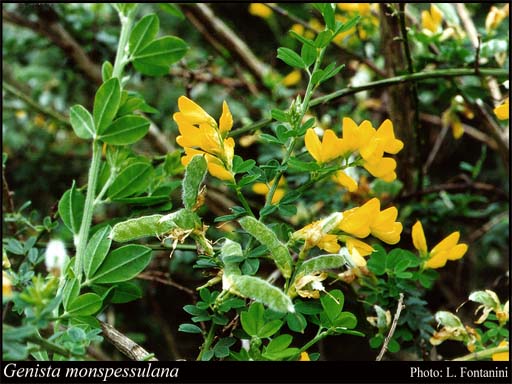- Reference
- Contr.New South Wales Natl.Herb. 3:98 (1962)
- Conservation Code
- Not threatened
- Naturalised Status
- Alien to Western Australia
- Name Status
- Current
Erect shrub, 1-5 m high, leaves trifoliolate, petiolate, standard more or less glabrous. Fl. yellow, Aug or Nov or Jan. Loam, lateritic sand, black peaty sand. Edging rivers and roadsides.







Scientific Description
Genus Genista. Form erect. Habit shrub, spindly shrub (broom-like). Stems Indumentum hairy, Pustules or glands absent, Striation (stems ribbed) striate, Cross section terete, Spiny on any part of plant not spiny. Leaves or phylloclades Presence clearly present, Position alternate, Leaves compound, Leaves or phylloclade continuous with stem not continuous with stem, Cross section of leaf or leaflet flat with flat margins, Margins of leaf or leaflet entire, Tuberculate tubercles absent, Pustules or glands absent. Length Leaf length 10-25. Width (entire leaves only) Leaf width NaN (?). Scale leaves length mm long NaN (?). Leaflets Number three. Indumentum Presence hairy, Type simple. Stipules Presence apparently absent even from the youngest leaves, Glands with glands (?) or without glands (?), Ribs ribbed (?) or ribless (?). Length Stipule length NaN (?). Bracteoles Presence present and persistent (?), absent (?) or present but early deciduous (?), Indumentum hairy (?) or glabrous (?), Striation striate (?) or not striate (?). Length Bracteole length 1.2-1.6. Pedicel Presence present, Indumentum hairy. Length Pedicel length 2-3. Calyx Pustules or glands absent, Ribs ribless, Enlarged in fruit not accrescent. Length Calyx length 5-6. Indumentum Presence hairy, Type with simple hairs. Corolla Colour patterning uniformly coloured, Colour (when uniformly coloured) yellow, Petal claws ( the narrow base of the petals absent. Length Corolla length 10-13. Indumentum Presence absent. Standard Indumentum glabrous, Auricles not auriculate. Length Standard length 11-13. Wings Auricles not auriculate. Length Wing length 10-11.5. Keel Auricles not auriculate, Indumentum glabrous, Beak not beaked. Length Keel length 9-12. Stamens Number nine (?) or ten (?). Anthers anther length 0.5-0.7, Position at two different levels (filaments alternately long and short). Filaments Fusion united in a closed sheath. Length Filament length 6-9. Ovary Placement stipitate. Indumentum Presence hairy or glandular. Style Indumentum hairy or glandular towards the base, Bearded ( with a tuft of hairs at apex ) not bearded, Apex terete. Length Style length 9.2-13. Fruit Type dehiscent (a pod or follicle), Constriction constricted between the seeds, Compression round in cross-section, Placement sessile or subsessile, Beak not beaked. Length Fruit length 15-20. Width Fruit width 5-6. Indumentum Presence hairy, Indumentum type with simple hairs. Flowering time January, August or November. Distribution Botanical Province South-West, IBRA Bioregion Avon Wheatbelt, Jarrah Forest, Warren or Swan Coastal Plain.
Distribution
- IBRA Regions
- Avon Wheatbelt, Jarrah Forest, Swan Coastal Plain, Warren.
- IBRA Subregions
- Katanning, Northern Jarrah Forest, Perth, Southern Jarrah Forest, Warren.
- IMCRA Regions
- WA South Coast.
- Local Government Areas (LGAs)
- Albany, Armadale, Augusta Margaret River, Bridgetown-Greenbushes, Busselton, Donnybrook-Balingup, Kojonup, Manjimup, Narrogin, Plantagenet, Wandering.
Management Notes (for the Swan NRM Region)
General Biology. Growth form. Shrub. Reproduction. Seed. Dispersal. Explosive action, birds, ants, water, vehicles, slashing, soil movement, garden refuse. Time to first flowering. 2 years. Toxicity. Seeds are poisonous to humans and livestock. Vegetative regeneration strategy. Resprouts from base. Seedbank persistence. Long, 10+ years. Fire response. Adult plants may respout following fire. Fire stimulates germination of soil-stored seed.
Notes. Fixes nitrogen and increases soil fertility . Can increase frequency and intensity of fire.
Additional information. Origin. Northen Africa, southern Europe, western Asia. History of use/introduction. Garden escape.
Suggested method of management and control. Hand pull or dig out small seedlings ensuring removal of all roots. For mature plants cut and paint with 50% glyphosate or try basal bark with 250 ml Access® in 15 L of diesel. Monitor site for recruitment from seedbank. Read the manufacturers' labels and material safety data sheets before using herbicides. For further information consult the Australian Pesticides and Veterinary Medicines Authority to determine the status of permits for your situation or state.
Management Calendar
| Calendar Type | Jan | Feb | Mar | Apr | May | Jun | Jul | Aug | Sep | Oct | Nov | Dec | Comments |
|---|---|---|---|---|---|---|---|---|---|---|---|---|---|
| Flowering | O | O | O | Y | Y | Y | Y | O | |||||
| Fruiting | Y | O | O | Y | Y | Y | |||||||
| Germination | Y | Y | Y | Y | Y | Y | |||||||
| Active Growth | O | Y | Y | Y | Y | Y | Y | O | |||||
| Optimum Treatment | Y | Y | Y | Y | Y | Y |
Legend: Y = Yes, regularly, O = Occasionally, U = Uncertain, referred by others but not confirmed.
References
- Bossard, C.C., Randall, J.M. & Hoshovsky, M.C. eds. (2000) Invasive plants of California's wildlands. University of California Press, Berkley. Los Angeles. London.
- CRC Weed Management (2008) Weed management guide. Scotch broom (Cytisus scoparius) and other introduced brooms. CRC for Australian Weed Management.
- Hussey, B.M.J., Keighery, G.J., Dodd, J., Lloyd, S.G. & Cousens, R.D. (2007) Western Weeds. A guide to the weeds of Western Australia. 2nd Edition. The Plant Protection Society of Western Australia, Victoria Park.
- Muyt, A. (2001) Bush invaders of South-East Australia: A guide to the identification and control of environmental weeds found in South-East Australia. R.G. & F.J. Richardson, Melbourne.
- Navie, S. & Adkins, S. (2008) Environmental Weeds of Australia, An interactive identification and information resource for over 1000 invasive plants. Centre for Biological Information Technology, The University of Queensland.
- Parsons, W.T. & Cuthbertson, E.G. (2001) Noxious weeds of Australia. 2nd Edition. CSIRO Publishing, Collingwood.
- Zouhar, K. (2005) Genista monspessulana. Fire Effects Information System, [Online].. U.S. Department of Agriculture, Forest Service, Rocky Mountain Research Station, Fire Sciences Laboratory URL: http://www.fs.fed.us/database/feis - Accessed July 2009.